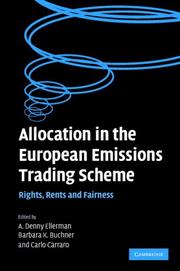| Listing 1 - 9 of 9 |
Sort by
|

ISBN: 0521660831 0521023890 0511528574 0511836643 9780521660839 Year: 2000 Publisher: Cambridge : Cambridge University Press,
Abstract | Keywords | Export | Availability | Bookmark
 Loading...
Loading...Choose an application
- Reference Manager
- EndNote
- RefWorks (Direct export to RefWorks)
A comprehensive description and evaluation of the first three years of the U.S. Acid Rain Program. This environmental control program is the world's first large-scale use of a tradeable emission permit system for achieving environmental goals. The book analyzes the behavior and performance of the market for emissions permits, known as allowances, and quantifies emission reductions, compliance costs, and cost savings associated with the trading program. The book also includes chapters on the historical context in which this pioneering program developed and the political economy of allowance allocations. Finally, the book discusses the program's successes, its weaknesses, and the lesson learned regarding application of the emissions-trading approach to controlling other types of emissions, including greenhouse gases. The volume is an indispensable addition to the library of all interested in the application of marker principles for meeting environmental goals.
Emissions trading --- Air quality management --- Acid rain --- Government policy --- Environmental aspects --- politique de l'environnement --- pollution --- eua --- milieubeleid --- vervuiling --- vsa --- Acid precipitation (Meteorology) --- Rain and rainfall --- Business, Economy and Management --- Economics --- Emissions trading - United States --- Air quality management - Government policy - United States --- Acid rain - Environmental aspects - Government policy - United States

ISBN: 9780521875684 9780511493478 9780521182621 9780511290381 0511290381 0511289170 9780511289170 0511289782 9780511289781 0511493479 0521875684 1107182247 9781107182240 1280917199 9781280917196 9786610917198 6610917191 0511322402 9780511322402 0511288492 9780511288494 052118262X Year: 2007 Publisher: Cambridge : Cambridge University Press,
Abstract | Keywords | Export | Availability | Bookmark
 Loading...
Loading...Choose an application
- Reference Manager
- EndNote
- RefWorks (Direct export to RefWorks)
A critical issue in dealing with climate change is deciding who has a right to emit carbon dioxide. Originally published in 2007, Allocation in the European Emissions Trading Scheme provided the first in-depth description and analysis of the process by which rights to emit carbon dioxide were created and distributed in the European Union. This was the world's first large-scale experiment with an emission trading system for carbon dioxide and was likely to be copied by others if there was to be a global regime for limiting greenhouse gas emissions. The book comprises contributions from those responsible for putting the allocation into practice in ten representative member states and at the European Commission. The problems encountered in this process, the solutions found, and the choices they made, will be of interest to all who are concerned with climate policy and the use of emissions trading to combat climate change.
Emissions trading --- Asset allocation --- Echange de droits d'émission (Environnement) --- Wetgeving, reglementering i.v.m. milieubeheer, milieuhygiene, verontreiniging. Milieurecht. Milieuhygienerecht--zie ook {?502/504}; {?613/614}; {628}--Europa --- 351.777 <4> Wetgeving, reglementering i.v.m. milieubeheer, milieuhygiene, verontreiniging. Milieurecht. Milieuhygienerecht--zie ook {?502/504}; {?613/614}; {628}--Europa --- Echange de droits d'émission (Environnement) --- BPB0801 --- 351.777 <4> --- Air --- Emissions credit trading --- Emissions rights trading --- Marketable permits for carbon dioxide emissions --- Tradeable emission permits --- Trading emissions credits --- Environmental policy --- Carbon offsetting --- Carbon taxes --- Allocation of assets --- Investments --- Portfolio management --- Pollution --- Affectation de l'actif --- Business, Economy and Management --- Economics --- Emissions trading - Europe --- Asset allocation - Europe
Book
Year: 2006 Publisher: London Centre For Economic Policy Research, International Trade. Discussion Paper Nr.5843. September 2006
Abstract | Keywords | Export | Availability | Bookmark
 Loading...
Loading...Choose an application
- Reference Manager
- EndNote
- RefWorks (Direct export to RefWorks)
Book
Year: 2008 Publisher: Arlington Pew Center on global climate change
Abstract | Keywords | Export | Availability | Bookmark
 Loading...
Loading...Choose an application
- Reference Manager
- EndNote
- RefWorks (Direct export to RefWorks)
Book
ISBN: 9782744063817 2744063819 Year: 2010 Publisher: Paris : Pearson,
Abstract | Keywords | Export | Availability | Bookmark
 Loading...
Loading...Choose an application
- Reference Manager
- EndNote
- RefWorks (Direct export to RefWorks)
Environnement --- Air --- Compensation des émissions de carbone --- Environmental law --- Emissions trading --- Carbon offsetting --- Echange de droits d'émission (Environnement) --- Droit --- Pollution --- Echanges de droits d'émission --- Compensation des emissions de carbone --- Echanges de droits d'emission --- Compensation des émissions de carbone --- Echange de droits d'émission (Environnement) --- Echanges de droits d'émission --- Emissions trading - European Union countries --- Carbon offsetting - European Union countries --- Politique de l'environnement
Book
Year: 1998 Publisher: Washington, D.C.
Abstract | Keywords | Export | Availability | Bookmark
 Loading...
Loading...Choose an application
- Reference Manager
- EndNote
- RefWorks (Direct export to RefWorks)
Book
Year: 1998 Publisher: Washington, DC : World Bank,
Abstract | Keywords | Export | Availability | Bookmark
 Loading...
Loading...Choose an application
- Reference Manager
- EndNote
- RefWorks (Direct export to RefWorks)
Developing countries-both importers and exporters-could in fact benefit from carbon dioxide emissions trading to achieve tagets mandated by the Kyoto Protocol. The trading of rights to emit carbon dioxide has not officially been sanctioned by the United Nations Framework Convention on Climate Change, but it is of interest to investigate the consequences, both for industrial (Annex B) and developing countries, of allowing such trades. Ellerman, Jacoby, and Decaux examine the trading of caps assigned to Annex B countries under the Kyoto Protocol and compare the outcome with a world in which Annex B countries meet their Kyoto targets without trading. Under the trading scenario the former Soviet Union is the main seller of carbon dioxide permits and Japan, the European Union, and the United States are the main buyers. Permit trading is estimated to reduce the aggregate cost of meeting the Kyoto targets by about 50 percent, compared with no trading. Developing countries, though they do not trade, are nonetheless affected by trading. For example, the price of oil and the demand for other developing country exports are higher with trading than without. The authors also consider what might happen if developing countries were to voluntarily accept caps equal to Business as Usual Emissions and were allowed to sell emission reductions below these caps to Annex B countries. The gains from emissions trading could be big enough to give buyers and sellers incentive to support the system. Indeed, a global market for rights to emit carbon dioxide could reduce the cost of meeting the Kyoto targets by almost 90 percent, if the market were to operate competitively. The division of trading gains, however, may make a competitive outcome unlikely: Under perfect competition, the vast majority of trading gains go to buyers of permits rather than to sellers. Even markets in which the supply of permits is restricted can, however, substantially reduce the cost to Annex B countries of meeting their Kyoto targets, while yielding profits to developing countries that elect to sell permits. This paper-a product of Infrastructure and Environment, Development Research Group-is part of a larger effort in the group to examine the impact on developing countries of programs to correct global environmental problems. Denny Ellerman may be contacted at dellerman@mit.edu.
Book
ISBN: 9780521196475 9781139042765 9781139042017 1139042017 1139042769 0521196477 9781139038102 1139038109 1107205174 1139035789 1283051915 9786613051912 113904124X 1139044648 1139040464 9781107205178 9781139035781 9781283051910 6613051918 9781139044646 9781139040464 Year: 2010 Publisher: Cambridge : Cambridge University Press,
Abstract | Keywords | Export | Availability | Bookmark
 Loading...
Loading...Choose an application
- Reference Manager
- EndNote
- RefWorks (Direct export to RefWorks)
The European Union's Emissions Trading Scheme (EU ETS) is the world's largest market for carbon and the most significant multinational initiative ever taken to mobilize markets to protect the environment. It will be an important influence on the development and implementation of trading schemes in the US, Japan, and elsewhere. However, as is true of any pioneering public policy experiment, this scheme has generated much controversy. Pricing Carbon provides the first detailed description and analysis of the EU ETS, focusing on the first 'trial' period of the scheme (2005-7). Written by an international team of experts, it allows readers to get behind the headlines and come to a better understanding of what was done and what happened based on a dispassionate, empirically based review of the evidence. This book should be read by anyone who wants to know what happens when emissions are capped, traded, and priced.
Emissions trading --- Carbon offsetting --- Echange de droits d'émission (Environnement) --- Compensation des émissions de carbone --- #SBIB:327.7H231 --- #SBIB:327.7H42 --- #SBIB:35H434 --- Carbon offset trade --- Carbon trading --- Carbon dioxide mitigation --- Air --- Emissions credit trading --- Emissions rights trading --- Marketable permits for carbon dioxide emissions --- Tradeable emission permits --- Trading emissions credits --- Environmental policy --- Carbon taxes --- Europese Unie: sociaal-economisch beleid, landbouw-, milieu-, cultuur- en communicatiebeleid --- Specifieke internationale organisaties en samenwerking: milieu --- Beleidssectoren: milieubeleid en ruimtelijke ordening --- Pollution --- Echange de droits d'émission (Environnement) --- Compensation des émissions de carbone --- Business, Economy and Management --- Economics --- Emissions trading - European Union countries --- Carbon offsetting - European Union countries
Digital
ISBN: 9781139042765 Year: 2010 Publisher: Cambridge Cambridge University Press
Abstract | Keywords | Export | Availability | Bookmark
 Loading...
Loading...Choose an application
- Reference Manager
- EndNote
- RefWorks (Direct export to RefWorks)
| Listing 1 - 9 of 9 |
Sort by
|

 Search
Search Feedback
Feedback About
About Help
Help News
News